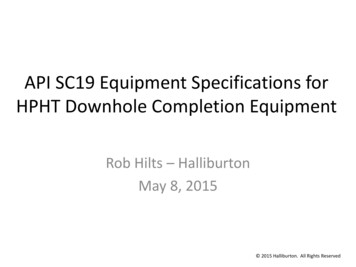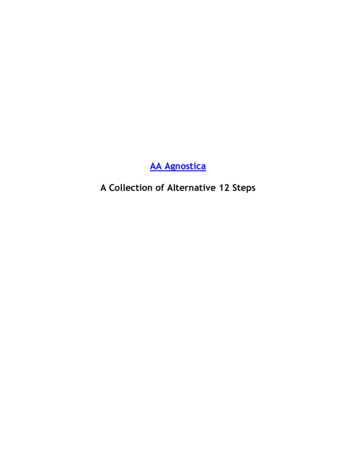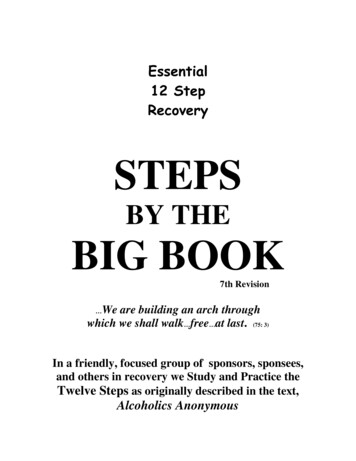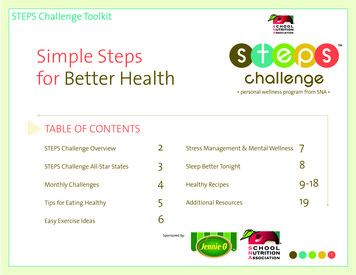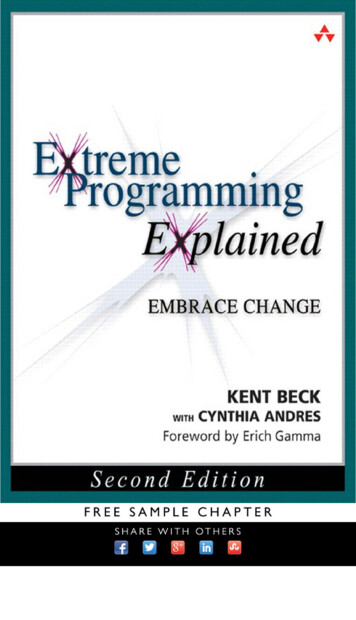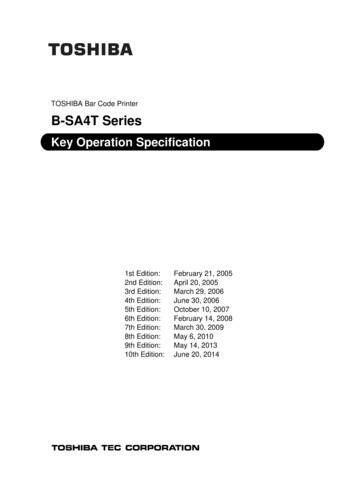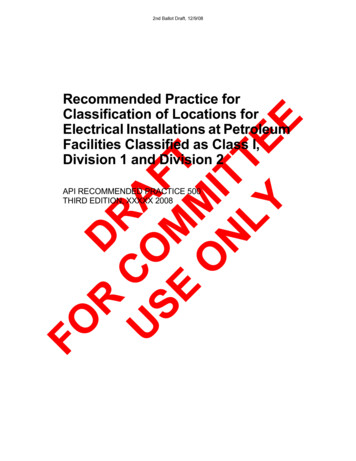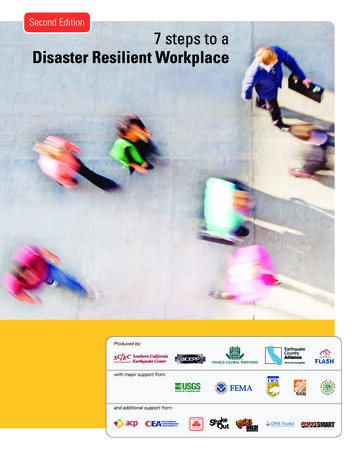
Transcription
Second Edition7 steps to aDisaster Resilient WorkplaceProduced by:EarthquakeCountryAllianceWe’re all in this together.with major support from:and additional support from:TM
Copyright 2016Earthquake Country Alliance,Southern California Earthquake Centerat the University of Southern CaliforniaReproduction by permission only.Disclaimer: The suggestions, photos andillustrations included in this document areintended to improve earthquake awareness and preparedness; however, they donot guarantee the safety of an individual,organization, or structure. The writers,contributors, and sponsors of this handbook do not assume liability for any injury,death, financial loss, property damage,or other effect of an earthquake or otherdisaster.7 Steps to a Disaster Resilient Workplacewas prepared by the Earthquake CountryAlliance (ECA) Business Committeein cooperation with the support frommembers of the ECA and other partners(see cover). Significant funding for thepreparation, design and printing of thebooklet was provided by the FederalEmergency Management Agency (FEMA),California Governor’s Office of EmergencyServices (CalOES) and administered byFLASH. (2016 update).Producer:Mark Benthien, SCEC / ECAWriter/Project Lead:Inés Pearce, Pearce Global Partners Inc.Writers: Amgen Inc.: Chris Wright;NBC – Universal: Mike Ripley; MathewsConsulting: Nancy Mathews; Associationof Contingency Planners (ACP) – OrangeCounty Chapter: Rhonda Russell;CapitalSource Bank: Joe Jaramillo; JillGanonContributors and Supporters: NBC –Universal: Bob Cavaglieri; BICEPP/Caltech:Margaret Vinci; FLASH: Barbara Harrison;CalOES: Kate Long; ACP – Orange CountyChapter: Monique Weiland; Bob Lee; andmany other members of the EarthquakeCountry Alliance.Special thanks to additional membersof the Business and Industry Council forEmergency Planning and Preparedness(BICEPP) and the Association ofContingency Planners for their support.Design: Denton Design Associates:Margi Denton, Elizabeth BurrillPhotography: Ann Elliott Cutting27 STEPS TO ADISASTER RESILIENTWORKPLACEEach step in this booklet will provideyou with a chance to identify areas inyour business that need strengthening, training opportunities, and actionsto be taken. They are designed sothat every step builds from the last.Customize each step to suit yourbusiness type and needs.SETTING THEFOUNDATIONIdentify potential hazards.Which hazards pose risks to your organization, and how? In this step, you will identifywhat may interrupt your operations temporarily or worse. The priorities you set herewill help you in the other Steps.BEFORE STEP1Secure Your Space (page 8)While this booklet assists addressingall hazards, we use an earthquakeas our primary example. To get youstarted, here is a snapshot of the7 Steps.Look at the priorities you just identified,where your organization is vulnerable tointerruption, and now choose how to minimize these risks. As an example, earthquakeshaking can move almost anything, evenlarge or heavy items. Imagine your workplace being picked up and shaken sideways– what would be thrown around? Learn howto secure these items to prevent damage orinjuries to employees.
STEP2Plan To Be Safe (page 9)After you have identified the potential hazards and impacts to your business, it’s timeto create your plan and train employees!Because disasters are highly unpredictable,it is impossible to anticipate every situationand impact. However, a Business ContinuityPlan can greatly reduce the risks and lossesyour organization might face by guiding yourdecisions yet allowing flexibility to adapt tothe unexpected.STEP3Organize disaster supplies (page 10)After a disaster, organizations will need tobe self-sufficient as first responders will beaddressing high priorities such as hospitalsand schools. Determine what you needin the first days following an earthquakeincluding the basics like food, water andsanitation.STEP4STEP6Minimize Financial Hardships (page 11)Improve Safety (page 13)Organize your important documents,strengthen your property, and considerinsurance—customized to cover your mostneeded items. Most businesses lease theirspace, so it’s essential to work with yourowner and property manager on addressingstructural issues. If you own it, strengthenthose weaknesses. Either way, measurestaken now can help you keep your doorsopen. No access, no business.Life safety is the top priority after an earthquake or any disaster. Activate your owntrained personnel to find and help anyoneinjured, as outside help may not be coming.Next, survey your building for damage orother hazards to prevent further injuries ordamage. Decide if safe to stay.AND AFTER STEPDURING STEP5Drop, Cover, and Hold On (page 12)The ground is shaking, what do you do?Everyone should know how to protect themselves in any situation. Most often this willbe to Drop, Cover, and Hold On, but this candepend on your location. Stay clear of anyobjects that may fall and stay put until theshaking stops.7Reconnect and Restore (page 14)Once life safety is being addressed, it’stime to begin recovery activities to resumeoperations. Conduct an assessment foroperational issues then repair damage. Useyour plan to guide your actions and restorepriority operations first. Communicate oftenwith employees and key contacts. Document your lessons learned to determinepriorities before the next event.This booklet lists good resources within thecontent and on the back page. For additionalinformation and details, please visit www.ResilientWorkplace.org3
WORKING THROUGH DISASTERSEarthquakes and other disasters can and will happenin many parts of the United States while you are at work.While the actions described in the “Seven Steps to Earthquake Safety” (www.EarthquakeCountry.org/sevensteps)are focused on improving earthquake safety at home,this booklet provides guidance on creating a resilientworkplace – for any disaster.Every area of the country relies on their local businessesand non-profit organizations to remain open after adisaster in order for the community to recover quickly.For this to happen, people need to prepare at home and atwork. If your workforce is not ready at home, they may bedealing with tragedy and unable to return to their jobs —what will you do without employees? It is just as importantto protect your physical building and the contents insidefrom damage, as well as train your employees on what todo when disaster strikes at work — without taking theseactions, you may have work stoppages or worse.4Great news — it doesn’t have to come to that. Here are7 simple steps to guide your business or organization todisaster resiliency by taking actions before, during, andafter the shaking occurs so you can recover more quickly.This guide will focus on steps to prepare and protectyou from earthquakes as a primary example but it willalso discuss and help you prepare for all hazardsanywhere in the U.S. For specific earthquake hazardinformation, see the resources listed in the back for moreinformation. No matter what your industry or the size ofyour organization, you can start today. And remember we’re all in this together!
IDENTIFY YOURNEEDS ANDPOTENTIAL HAZARDSThe information you gather herewill help you prioritize your planningprocess and create your foundationto complete the Steps. In orderto plan, you will need to recognizepotential hazards and how theymay interrupt a part or all of yourworkplace.To begin, take a sheet of paper andmake a list of your hazards. To simplify this,here are examples of overall hazards thatcan cause more specific disruptions from asmall to a catastrophic scale: earthquakes,fire, flood/water damage, tornado, hurricane,human error, power outage, theft, etc. Mostinternal/external hazards will fall underone of these. For more ideas of hazards toconsider on your list, please visit www.ResilientWorkplace.org. We will explain how toactually address these hazards later.To begin identifying your potential internalhazards, start by surveying your area. This isas simple as walking around your organization and neighborhood. Look for hazards bothinternal to your organization and external toyour facility. Ask yourself a few questions tospark issues: What’s around me? What shouldI be concerned with that may interrupt myoperations?MY HAZARD LISTEARTHQUAKEFIREPOWER OUTAGEFLOODTORNADOTHEFTSECURITY RISKSTORMSOne of the most common disruption or lossto small organizations is a vulnerability oftechnology by not backing up computer dataat all or only to the desktop, then somethinghappens to the computer taking with it all thepertinent files and information. Here are a fewmore examples:POTENTIAL INTERNAL HAZARDS:b Unbraced shelves located next to exitsb Filing cabinets not bolted to the floor or wall studsb Heavy or breakable items on high shelves or bookcasesb Not backing up computer data and/or not storing back-ups off siteb Utilities located in the basement or on the floorbbPOTENTIAL EXTERNAL HAZARDS:b Other businesses in your area who may experience a disaster which could impact youb Brick elements in your building structure or façadeb Near a railroad, airport, freewaysb Near a water source, such as a riverbb5
Identify Critical AssetsCRITICAL BUSINESS torsvolunteersDATAdocumentsfilesrecordsserver back-upsOPERATIONSLook at your standard operating proceduresor SOPs and think of a disruption to yourrevenue generating operations or the criticalservices you provide.Accounts Receivable or PayablePayrollManufacturingMail RoomFood delivery to at-home seniorsMedical care for people with disabilitiesor access and functional needsINVENTORYStocksuppliesraw materialsEQUIPMENTComputers (hardware & software)serversnetworkspecialty equipmentmanufacturing machinerycopiersfurnitureBUILDING(S)Physical structurestorage unitwarehousemain officestore frontcapital leaseNow make a second list to identify yourorganizations’ most critical assets. These arethe items that if they were taken away, wouldcause disruption in your workplace. Tosimplify identifying them, all your assets willfall into one of the following six categories:people, building, equipment, data, inventory/products, and operations. Regardless ofyour type of business or organization, losinga critical asset may cause significant financialloss.The assets will differ from one organization toanother, although sectors and industries sharecommonalities. Here are examples of assets ineach of the categories.Once you have your list of hazards and listof assets, you’ll be ready to assess where yourworkplace is vulnerable to disruption. Foreach of your six categories, you will thendecide the level of impact each hazard willhave. The exercise on the next page willassist you in prioritizing areas that need tobe addressed.Before you begin completing the table onthe right, you will need to understand thedifference between the levels of impact. Theyare listed in order of escalation.Negligible – limited to no organizationaldisruptions or property damageMarginal – a hindrance that may effect operationswithout shutting down, you have no or minordamage, it may be an occurrence in neighborhoodCritical – temporary disruptions of operations ormajor damage to the facility, impacts are tocommunityCatastrophic – a disaster that affects entireregional community causing workplace disruptions and forces closure of building(s). This is anevent of large proportions. It can include complete destruction, multiple injuries or deaths,and a regional event that means limited or nooutside resources available for some time.On the right is a table to help you determineand prioritize your workplace risks. Generaltypes of events are listed in the left-handcolumn, but add your own in the blanksprovided.Begin with the first listed disaster event,earthquake. Circle the number in each assetarea to score how the hazard would likelyimpact your organization.6
RISK ASSESSMENT MATRIXIMPACT TO CRITICAL BUSINESS NSType of Event (samples)1 Negligible2 Marginal3 Critical4 Catastrophic1 Negligible2 Marginal3 Critical4 Catastrophic1 Negligible2 Marginal3 Critical4 Catastrophic1 Negligible2 Marginal3 Critical4 Catastrophic1 Negligible2 Marginal3 Critical4 Catastrophic1 Negligible2 Marginal3 Critical4 234Hurricane123412341234123412341234Power 1234Volcanic Eruption123412341234123412341234Winter lete the other rows then total yournumbers for both columns and rows. As thelast step, prioritize which areas should beaddressed first, based on highest vulnerability,then assign each column with your prioritynumber 1-6.Most people know earthquakes are a realrisk. If you haven’t already, refer to the U.S.Geological Survey seismic hazard maps as itmay be a higher risk than you think.Need another copy of this table? Please visitwww.EarthquakeCountry.org/workplaceand download it.Congratulations, you have finished assessingyour risks. If you haven’t involved others inthis process yet, consult with personnel inyour organization about the results to ensureyou are considering the whole organizationalpicture. No one-person knows every facet toan organization, so ask for their thoughts andrevise priorities accordingly.7
1SECURE YOUR SPACENow that you have prioritizedwhere you are vulnerable, hereis how to minimize your risk. Anexample is a business choosing toprotect specialty equipment, whichis difficult or expensive to replaceafter earthquake damage. If yousecure it, it can be saved.One of the questions that surfaces at this earlystage is cost. Many solutions are low or nocost. Others may be more complicated with ahigher price tag but when compared with protecting employees’ lives, property, inventory,and keeping the organization’s doors open, itbegins to balance out the decision. The benefitfor addressing hazards before the next disasteris that you do not have to suffer the pain andhigh cost of damage repair and replacement.If you add to all the post-disaster costs withthe psychological toll and stress, the predisaster solutions pay for themselves. A recentstudy shared by the Natural Hazard Centershowed: for every dollar spent addressinghazards pre-disaster, at least four dollars indisaster losses are saved.MayaManager, veterinary practice“Dogs, cats, birds, you name it —none of our patients can fend forthemselves during an earthquake.Between boarding, surgeries andappointments, we can have twentyanimals in the building. Talk aboutpotential chaos! I see six earthquake hazards without even movingfrom my desk. I’m bringing it up atthe next staff meeting.”8If you are not sure where to begin, start onhigh impact and low-cost solutions suchas moving heavy items to lower shelves. Animportant aspect to ensure success for thelong-term is to be diligent with continuingthe solutions. Moving heavy items back toshelf-tops after six months saves no one andonly adds to your organization’s vulnerability.Continue on the risk-reduction path byreinforcing and rewarding the safe behaviorof all employees, especially over time.The great news is that by addressing onesolution you may also be limiting the negativeeffects of multiple hazards. For instance,securing computers from earthquake damagecan also protect them from theft, or strengthening a structure for earthquakes can alsoprotect it in strong winds. Now you can beginaddressing those priority hazards.For great QuakeSmart checklists to securespace, systems, structure, staff and services;to get the simple, step-by-step plan-builder(DRB Toolkit ) that includes solutions formulti-hazards; or other resources, visitwww.ResilientWorkplace.orgIn your foundation work, you identifiedpotential hazards to your organization,determined your critical assets, and prioritizedthe impacts. In Step 1 you identified solutionsto mitigate impacts. You are now ready tobegin Step 2.TASK1There are many easy-to-do items thatdo not require technical personnel toaddress. Put these tasks at the top ofthe list, as you will have many quicksuccesses. Your employees will quicklysee a safer work environment emerging. These solutions do not take a lotof time or money, and can create greatmomentum towards getting the largertasks accomplished. Here are a fewexamples of these types of simple tasksand which impact areas they address: Move heavy items onto lower shelves.(people, operations, data, inventory,equipment) Lock storage cabinets and file cabinetswhen not in use. (people, operations,data) Do not stack boxes or have openshelves near exits. (people, operations,inventory) Keep space cleared under your deskso you can Drop, Cover, and Hold On.(people, operations) Secure laptops or other items that caneasily fall or be stolen. (people, operations, equipment, data)Note: These simple items are all internal toyour building such as its contents. Addressing building structural issues willbe covered in Step 4.
PLAN TO BE SAFEYou have identified potential hazardsand impacts to your operations - timeto create a plan! Because disastersare unpredictable, it is impossible toanticipate every situation or impact.However, a Business Continuity Plancan aid decision-making and communication in any crisis.2aTASK2BASIC PLAN ELEMENTSEvery organization and their risks are unique, but basic plan elements apply to all.Determine which elements make sense and should be included in your plan. Even if youonly include some basic elements in your plan, you will be ahead of the pack!bEMPLOYEE EMERGENCYCONTACTS. It’s crucial to contactemployees and their families during adisaster such as if employees are injured,sick or unable to leave work. Also, if youmust share regarding the organization’sstatus, where to go and what to do following a disaster. Create call lists includingwork, cell, home numbers, emails, socialmedia (contact info/link/pages/names)and the same for spouse or significantothers.bKEY CONTACTS LIST. Key contactsare vendors, suppliers, clients, customers,etc. that you rely on to conduct operationsor may need to notify when you’ve beenimpacted by a disaster such as propertymanagement, utility companies, businesspartners, board, or others. You will alsowant to determine if they have beenimpacted and how that will affect you consider Service Level Agreements (SLA)to identify their responsibility to you.Collaborate on Your PlanIn disasters, first responders will be limited,focusing on priorities such as hospitals,schools. Instead, work with neighbors andsimilar organizations to identify needs aheadof time, then help each other by sharing resources, supplies, locations, etc.bGeorgeOwner, construction company“First aid situations come up in construction, but earthquakes — I needtraining for myself and everybody whoworks for me. Withcrews and heavyequipment out onthree or four jobs,how can I expectmy foremen tomanage their sitesduring a disasterunless I havedisaster plans inplace, and makesure we all getschooled. I putnew people onall year long sowe need regulardrills to keep thingscalm if it startsshaking.”bbCRITICAL BUSINESS FUNCTIONS.Identify and prioritize those in youroperations that are critical for survival;are necessary to fulfill legal / financialobligations; and are necessary to maintaincash flow and/or reputation. How long canyou be down and remain viable? How willyou continue performing these functionsin disaster and who is relying on you forproducts or services.VITAL RECORDS. Identify thoseessential to perform critical functionssuch as employee data, payroll, inventory,financial and insurance records, customerdata, legal and lease documents. Are anyimpossible to re-create, are copies storedoffsite, or are they accessible online?CRITICAL EQUIPMENT/MACHINERY. Determine what isnecessary to keep you operational. Whatif you lost critical equipment? Do you havespare parts or equipment stored offsite orcan you get replacements?bbRECOVERYLOCATIONS. Can yourecover from an alternatesite? Do you have multiplelocations or are you sitedependent? Considersetting up another site orcreating an agreement torent space in a disaster.Can you co-locate witha neighbor, partner orcompetitor?LIFE SAFETY – EMERGENCYRESPONSE. As local first respondersmay not be available, create your on-siteteam of first responders and train themto help save lives using now/low costresources. Conduct annual training anddrills such as:b Evacuationsb First Aid/CPRb Fire Safety and Extinguishersb Great ShakeOut Earthquake Drills:Train all employees to “Drop, Cover, andHold On” and participate in the annualdrill at www.ShakeOut.orgbPLAN EDUCATION. Educate employees on your plan, how it works, recoverystrategies, call trees, etc., Also, provideinformation on individual/family preparedness as employees ready at home willpromptly return to work and assist yourorganization.bMAINTENANCE AND TESTING.Update the plan when a change in yourorg impacts the information in the plan.Testing your plan is very important, as it’sthe only way to know if your plan worksand employees know what to do!For a simple, yet comprehensive, step-bystep plan-builder to become a more disasterresistant business (DRB) or organizationget the DRB Toolkit at www.ResilientWorkplace.org, along with other greatresources.9
3AnnaDirector, hotel building staffORGANIZE DISASTER SUPPLIES“There’s ample opportunity for confusion on a good day at a big hotel. Butstaff and guests are most likely to riseto the occasion when measures arein place to meet their most basic food,safety, hygiene and communicationneeds. We keep food and water inour disaster supply kits current; andwe’re seeking expertadvice about stockpiling medicalsupplies that will gobeyond the medicalcapacity of thefirst aid kits wealready haveon hand.”First responders and supplies maybe overwhelmed after an earthquakeor other disaster. Organizationsshould take basic measures to be selfsufficient during the early phasesafter disaster. Remember: food,sanitation, etc., may not be available.Encouraging employees to be prepared at home and work will also aidin prompt resumption of your criticaloperations.First Aid Kits vs. Disaster SuppliesTASK3As outside resources will be very limitedafter an earthquake, organizations shouldstockpile some supplies in order to supportyour employee base in the initial phases ofa disaster. Emergency and Disaster suppliesshould be easily accessible, in protectedlocations, and easily dispersed. Keep trackof perishable disaster supplies and replaceregularly. Also, employees should be encouraged to keep a minimum three-day supplyof personal medications at work, copies ofprescriptions, and extra glasses or contacts.10Most businesses have a requirement tofurnish first aid kits in the workplace due toOccupational Safety & Health Administration (OSHA), state, or other regulations. Firstaid kits are only one part of supplies neededto support an employee base after a disaster.As first aid kits are designed to handle onlyday-to-day minor injuries, organizationsshould consider stockpiling additional medicalsupplies to handle a greater number and largertype of injuries. Additional supplies shouldmatch the level of employees’ training.DISASTER SUPPLIESA minimum 3-day supply should be kept on hand including:bFIRST AID KITS/MEDICAL SUPPLIES – cuts are most likelyinjury so have bandages, pads, wrapsbbbbbbbbbbbFOOD – canned, packaged, ready to eatWATER – enough for one gallon/per person/per dayLIGHTING – flashlight & extra batteries, lanterns, light sticksCOMMUNICATIONS – portable AM/FM radio and extra batteries, portable TVTOOLS – basic hand tools: hammers, screw-drivers, wrenches, etc.PERSONAL PROTECTIVE EQUIPMENT – hard hats, gloves, dust masksTARPS/PLASTIC SHEETINGFOOD PREPARATION – portable stoves/grills for outdoor use, can openers,mess suppliesHYGIENE AND SANITATION SUPPLIESBACK-UP POWER – generator & extra fuel, batteries, uninterruptable power supply (UPS),and consider other sources: e.g. solar, hand-crankedADDITIONAL SUPPLIES to meet the training level of your employees: first aid,Community Emergency Response Team (CERT), EMT4MINIMIZE FINANCIALHARDSHIPIn your foundation work and Step 1,you identified hazards most likely todisrupt your organization and how toaddress lower cost ones. Review theanalysis for any priority you chose toreduce or eliminate the potential forinjury, property damage or businessinterruption. As the impacts can lastfor weeks and months begin to minimize financial hardships by organizingimportant documents, strengthening your property, and consideringinsurance. Structural hazards cancause serious impacts and interruptions your operations. Address anystructural hazards, as the cost of notaddressing them will be even higher.Organize important documentsIf you have to leave work quickly, due to a fireor other emergency, and not be able to return—what key info or documents do you needfor decision-making (lease, legal agreements,emergency contacts, insurance policies, etc.)?Create a “grab-and-go” bag or case, that issecure and possibly waterproof, so it can gowith you.In identifying critical documents, make sureyou protect your vital records. Back-upcomputer files on regular basis and storeback-ups at an off-site location (e.g. the cloud,fire safe at home, off-site storage). Know that“auto backup” is only to that computer and notoff-site. Stored data can include client history,inventory records, or other informationdifficult to recapture or required to beprotected, such as grant documentation.
The goal of all organizations is to continueoperations or restore them as quickly aspossible following a disaster. Taking stepsnow will save much time, money and energyafter disaster and will increase your ability toremain operational. Consider getting involvedwith organizations that connect tenants withowners,(e.g. Building Owners and ManagersAssociation (BOMA)).LeeStore manager, clothing shop“I love working in a place that’s an architectural treasure. But is the groundfloor of this hundred year old, four-storybuilding structurally sound? I have noidea, so I sent an email to my boss, andcopied it to the owner of the building.We’re meeting next week to talk aboutpossible hazards.”Consider insuranceStrengthen your propertyLeaseWhile most organizations do not own theirbuilding, it is essential to work with yourowner and/or property manager on addressing structural issues (e.g. floor, ceiling, walls,support columns). A good relationship canassist you getting access to your property orinventory, while structural damage can keepyou from opening your doors. If you ownyour building, take the time to strengthenweaknesses, replace elements that may injurepeople or keep you from reopening. Strengthening protects you, your employees and customers, and allows you to return to operatingmore quickly.If you lease your building, contact yourowner/property manager and develop arelationship with them now, before a disasteroccurs. If you uncovered a need to retrofityour building, work with your owner/managerto get various reputable, licensed, experiencedretrofitters to give estimates and considerstrengthening options. Also, discuss how youwill communicate with each other followinga disaster. Without connections in advance,tenants may not get access to their site afteran event.Depending on the hazard, consider solutionssuch as earthquake retrofit, hurricane shutters,elevating for flood or installing flood resistant doors. While retrofitting or elevating thestructure can be a significant cost, if you arereliant on that building to operate consider thecost to mitigate versus not having a building.No access, mean no business.After Hurricane Sandy, we learned many smallbusinesses/non-profits did not have any insurance or the right type, like flood insurance, tocover impacts. The lesson learned too late isto review your policy and make an informeddecision to select the one that covers yourmost critical equipment or operations. Mostorganizations do not have reserves to addressimpacts such as damage repairs and recovery.Consider cost of the deductible versus cost forall losses, then consult with an agent about options, such as business interruption insurance.Learn about the other safety systems in place.Does the building have sprinklers? Does ithave smoke and/or heat detectors? Does ithave emergency power? How has the building and surrounding area been effected bydisasters in the past? Asking these types ofquestions now will help you with customizing your own disaster plan and emergencyresponse procedures.OwnBring in expert advisorsNot sure where to start? Do some homeworkto determine which additional measures areneeded to protect your workplace. Ideally do itbefore you lease or purchase a facility. Learnwhat damage might be expected to help youprioritize solutions. Structural engineers andlocal Fire Marshall may help you understandthe building code and how its application affects your building. Depending on year built,a building may be designed to not collapse,but still may not be operational following anearthquake. Also, if needing to relocate, keepcode issues in mind for the new site.Organizations who own their buildings shouldlook to the expert guidance in addressingidentified vulnerabilities. Prioritize fixingweaknesses based on those that could mostsignificantly impact your ability to do operate. If you know you need to strengthen yourbuilding, consult with licensed, reputable, experienced retrofitters to discuss your options.Home-based businesses are considered a highrisk group, since you have the potential oflosing both your business and
7 STEPS TO A DISASTER RESILIENT WORKPLACE Each step in this booklet will provide you with a chance to identify areas in your business that need strengthen-ing, training opportunities, and actions to be taken. They are designed so that every step builds from the last.

